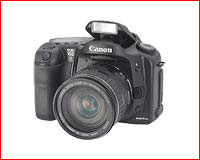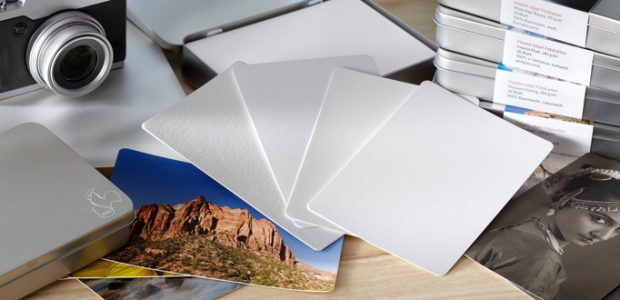stalk·ing-horse
Pronunciation: ‘sto-ki[ng]-"hors
Function: noun
Date: 1519
1 : a horse or a figure like a horse behind which a hunter stalks game
2 : something used to mask a purpose

Please note that this is not a comprehensive review of the Canon EOS-10D. Due to a series of misadventures, including a major delay in my receiving a sample from Canon, cancelled shooting trips, and bad weather during my actual testing week, I was unable to perform my usual field report. So instead this will be in part a reflection on the evolution to date of Canon’s entry level digital SLRs, where we stand today with the 10D, and where things may be going in future.
In the beginning there was the D30. Then 18 months later the D60 arrived. Now, less than 12 months after the introduction of the D60 we have the EOS 10D. Put them side by side and even a second look would lead you to think that they were the same camera. But they’re not — not by a long shot. In fact the 10D’s resemblance to the D60 is limited to major cosmetics and the imaging chip. It is really quite different in several respects, which we’ll look in a moment.
But the questions that many people have asked is — why was the 10D introduced so soon after the D60, particularly when the D60 didn’t really ship for months after its introduction, and never shipped in sufficient quality to satisfy demand? I’m not sure that I really know the answers, but here is some speculation based on discussions with a number of industry insiders.
First, the story is that Canon underestimated the demand for the D60 and was never able to sufficiently ramp up production to meet it. Secondly, a new chip plant didn’t come online until the end of 2002, and this, combined with a better feel for demand will ensure that now that the 10D is shipping Canon will be able to fulfill orders worldwide on a timely basis.
Thirdly, Canon appears to be intent on becoming a dominant force in digital cameras, and they needed a purpose-engineered DSLR that would allow them to move forward aggressively, since marketplace competition is forcing all manufacturers to obsolete themselves, not to mention the competition, every 12 months or even less.
Whichever aspects of this are true, it’s clear that Canon will market the 10D very aggressively. I’ve heard that as the competitive environment demands they will be able to drop the price, possibly as low as under $1,000 street price by early 2004. This explains the brand new body — that though it looks like a D60 is in fact essentially a brand new camera.
All of this is of parenthetical interest to most consumers. They want to know about the camera’s features and capabilities and how it performs, not about the business side of things. But, because of the Net, and the ability of consumers worldwide to communicate with each other in real time, such discussions are of interest to hobbyists as well as others.
When I review a new camera my interest is not in enumerating every bell and whistle, but rather using the camera in the field and judging how well it performs its intended task. In fact I believe that this is the only site that tests new gear in this manner. This time round though, with the 10D, I won’t be able to do so to the extent that I would wish. I had planned a special shoot atBig Surto test the 10D on location, but the promised camera never arrived. I then could have used it a few weeks later on a shoot inUtah’s southern National Parks, but it was not to be. By the time my testing sample finally arrived I had no location shoots planned for the month and lots else on my plate. Then, the week that I did have for field testing turned out to have a major ice storm. Such is life.
The good news though is that in the intervening time other 10D reviews have started to appear online. The best of them is Phil Askey’s onDPReview. Phil has done his usual rigorous job, dissecting every nut and bolt. So here, rather than repeat the gory technical details I’ll take a quick look instead at what makes the 10D new and special and then offer some thoughts on the current state of the industry.

Symmetry — Loxahatchee National Wildlife Reserve. April, 2003
Canon 10D with Canon 400mm f/5.6L lens at ISO 800
____________________________________________________
Compared to ?
Though it looks like aD60it is a completely different camera in many ways. In fact it owes more to the 1D and 1Ds from a feature point of view than to the D60. It even betters them in a couple of respects. Yet, it is compatible with many of the D60’s accessories, such as theBG-ED3vertical grip / battery expander, and the Lithium Ion batteries are the same as well. This is quite a bit nice bit of engineering — a new camera body compatible with old accessories.
Unlike the D60, and the D30 before it, the 10D comes with a much smaller single battery charger rather than a 2 battery charger. This will be an advantage to some users since packing it for travel becomes much easier. The 2 battery charger is still available though as an accessory for those that might need it. Also, there is no battery dummy for use with an AC adapter. This too is now an optional accessory, though since sensor cleaning can now be done on battery rather than AC only the adaptor won’t be required by everyone.
Though not really a visible change, the move from an all polycarbonate to a magnesium alloy body is a real plus. This makes the body much more rigid, and should prove of benefit to outdoor photographers who handle their cameras with less than kid gloves. You can actually feel the difference. Squeeze a D30 or D60 and the body flexes slightly. Squeeze a 10D and it’s absolutely rigid.
The Achilles heel of the D30 and the D60 was its abominable autofocus. Canon has now taken the 7 point autofocus from its Elan series and used it in the 10D. While not up to the speed and versatility of the 45 point autofocus in the 1D and 1Ds, the 10D’s autofocus is now on par with competitive offerings from other manufacturers, and maybe even a bit better than some.
There are two new features found in the 10D that don’t even exist in the 1D and 1Ds. The first is an automatic orientation sensor that tells the camera if a shot has been taken vertically or horizontally and then tags the image so that it shows up with the correct orientation on screen. The second is a feature which I’ve been asking Canon for for a couple of years; a mode which automatically switches from single shot focus to focus tracking if the subject starts moving. Hooray!
But, all is not perfect with this new mode calledAI Focus. The idea is that when the subject is stationary the focusing mode acts the same as One Shot. Focus the camera on a stationary subject and it locks on. When the subject starts to move (such as a bird taking off) it changes toAI Servomode and starts focus tracking. Great. But, it isn’t that simple. Three days of testing with a 400mm lens at a wildlife reserve in south-central Florida showed me that the camera auto-switches to AI Focus when the camera is moved, not just the subject, and it doesn’t switch back readily. A nice first attempt at a solution, but by no means ideally executed.
The 10D has superior image playback and magnification over the 1D and 1Ds, and the top ISO speed has been increased to 3200 (more on this below). One area that has not been improved on the 10D is the viewfinder image size and brightness. This is still on the small and dim side, and while comparable to competitors like the Nikon D100 and Fuji S2 it doesn’t hold a candle to the 1D and 1Ds.
Quite a few other features from the 1D and 1Ds have found their way into the 10D though. These include the ability to set colour temperature precisely in degrees Kelvin, white balance bracketing, availability of the Adobe RGB colour space, autofocus point registration, FAT 32 support (for CF cards larger than 2GB) and Safety Shift mode — which prevents under or over exposure in aperture priority and shutter priority modes. Whew.
Compared to the D60 the 10D has a more responsive shutter mechanism. The top LCD panel is larger and more comprehensive in its information and the control buttons have been moved to the front edge of the top panel where they are more readily accessible. And though it’s just a small cosmetic matter, the very cheap looking silver-topped mode dial has been redesigned and now has a much more appealing look.
The included RAW conversion software is better than it’s been in the past, but still not as good as third party offerings. If Canon Japan would just learn how to write decent image processing software there’d be hardly anything to complain about. But in the meantimeBreezebrowsernow supports the 10D andCapture One LEallows 10D RAW images to be processed at their best.
____________________________________________________
Noise — Not!
Since the D30 was introduced 3 years ago Canon has excelled in producing low noise images, especially at medium to high ISOs. I regularly shoot with myCanon 1Dsat anything between ISO 100 and 400, because there is hardly any difference in visible noise, especially when processed thoughCapture One.
Now with the 10D, and in conjunction withCapture One LE, the bar has been raised another notch. The frame below says it all. It was taken at ISO 1600. Click on it and view a larger version and then look at the 100% detail crop below. There’s noise, but more like the grain that one is used to seeing from ISO 400 film. And, there is none of the blocking up of shadows and reduced resolution that one is used to from using fast colour films.
Canon 10D with 400mm f/5.6L lens at ISO 1600
If like me you find yourself shooting in low light levels, whether sports, wildlife or documentary, you owe it to yourself to have a look at the Canon 10D. It really does set a new benchmark in high ISO image quality. With the Canon 10D ISO 800 is a fully usable speed, and 1600 looks pretty much the way 400 speed film did.

100% detail crop
This of course raises the inevitable question — what about ISO 3200? On the 10D this is activated through a Menu setting calledISO Expansion. When turned on this allows an H setting above ISO 1600 to appear, which is ISO 3200. Noisy? Ya, sure, as you can see below. But it allows for usable images in light levels that were previously out of reach. In the shot below I was able to use a 400mm f/5.6 lens hand-held in pre-dawn light levels that normally would have kept me in bed.


____________________________________________________
Who’s it For?
Like many contemporary cameras, the 10D is somewhat schizophrenic . In terms of build, image quality and capabilities it is what might be called aprosumercamera . Many pros have been working with the D30 and D60 for the past couple of years, producing commercial quality work. The 10D certainly will be bought by working pros for many of the same reasons. But the camera, like its predecessors has 7 different dummy modes (I mean automatic modes) along with the usual P, TV, AV and M. The addition of Adobe RBG and Color Temperature in degrees Kelvin indicate a camera for the more sophisticated user. Built in pop-up flash is appreciated by both amateurs and pros. It can really come in handy for filling shadows.
The automatedDEPdepth of field mode is Canon’s more limited A-DEP mode, found on its lower-end models, yet the body construction is cast alloy rather than plastic. Like I said — schizophrenic.
In the end the 10D will be bought by a broad range of purchasers. Entry level digital buyers will find that it meets their needs and gives them lots of room to grow and learn. Advanced amateurs and pros will find it to be a tool that effectively delivers high quality images, and does so at an attractive price. Many owners of 1D and 1Ds models will buy one as a back up body. In fact, a few weeks after returning my test camera to Canon I bought a 10D for myself as backup to my 1Ds. The D60, which had previously served that purpose, was sold to a friend as backup forhis1Ds. So to answer the question of those that will ask — is it worth upgrading from the D60 to the 10D?, my answer is — I did.
____________________________________________________
Conclusion
In a nutshell — if you’re in the market and don’t already own a high end DSLR the 10D will be very tempting indeed. Excepting that it doesn’t provide full frame (which may be more important to some users than others) the 10D has just about everything that it takes to satisfy even the fussiest photographer. Considering the price — it’s a steal at $1,500 or less — the 10D is undoubtedly the best digital SLR on the market today.
____________________________________________________
The Future?
The subtitle at the top of this page called the Canon 10D a"stalking horse". What do I mean by that? It seems to me that with the 10D Canon, as it did a half year before with the 1Ds, Canon has put a stake in the ground and said to its competitors —match this! While the D60, and the D30 before it were capable of excellent image quality, they were hindered by poor autofocus, and had become a bit under-featured compared to recent offerings from Nikon and Fuji.
The 10D changes this, and with the exception of full frame offers photographers of all stripes just about everything they could wish for. No, the build quality isn’t quite up to that of a 1D or 1Ds, (what else is?) and autofocus is just 7 point rather than 45 point. But the price difference is huge and the value for money excellent. If we accept that Canon has the margin built in to the 10D to be able to drop the street price to about $1,000, then it’s hard to see how they can help but dominate the DSLR marketplace for a while. Even at about $1,425, which is what it’s selling for in the Spring of 2003, the value is tremendous.
It goes without saying that Nikon, Fuji, and Sigma, the other three current competitors, and Pentax when their DSLR is released this summer (2003), will all be forced to match Canon’s price aggressiveness along with competitive build quality, image quality and features. From the point of view of consumers this is great news.
Where will things go from here? I have no special insights. Breaking the $1,000 retail barrier will be a major step, and is likely to happen within 12 months, or less. Inexpensive full-frame sensors though are still several years off. They simply are too difficult to manufacture, and cost too much to make. Only Canon currently appears to have figured out how to do it, and even then at $8,000 it is out of reach for all except working pros and those with Platinum credit cards. Industry scuttlebutt has been that Nikon had some full-frame prototypes available in early 2003, but they weren’t satisfied with the image quality / price equation, and so will hold off on a full-frame camera for some time. Contax’s offering last summer was a flop, and Kodak’sDCS Pro 14nhas turned out to be underwhelming.
So while it appears that full frame is still a few years off for the mass market, that doesn’t mean that DSLR development won’t be robust. In addition to steadily falling prices, we will see continuing improvements in both image quality and shooting convenience. In the meantime the Canon 10D is the current leader of the pack in terms of image quality, features, build quality and price.
____________________________________________________
You May Also Enjoy...
Hahnemühle Paper Specialty Products
In the last article published Mark Segal did a great job explaining the Hahnemühle specialty paper products. I am all about making prints and Getting


